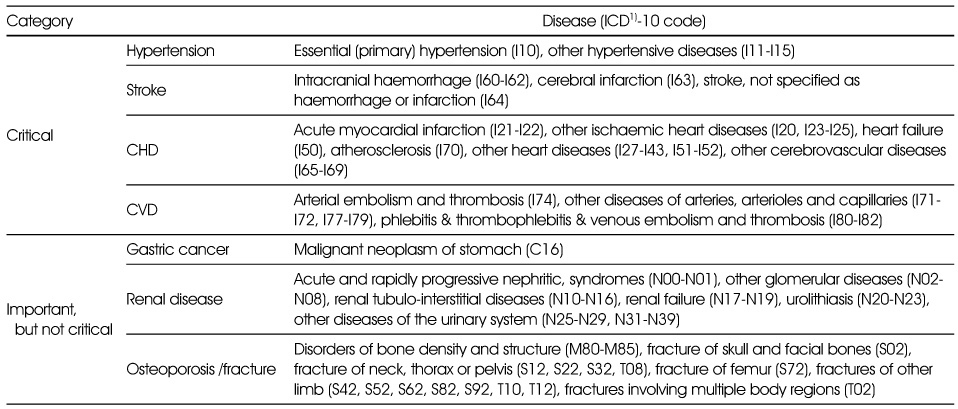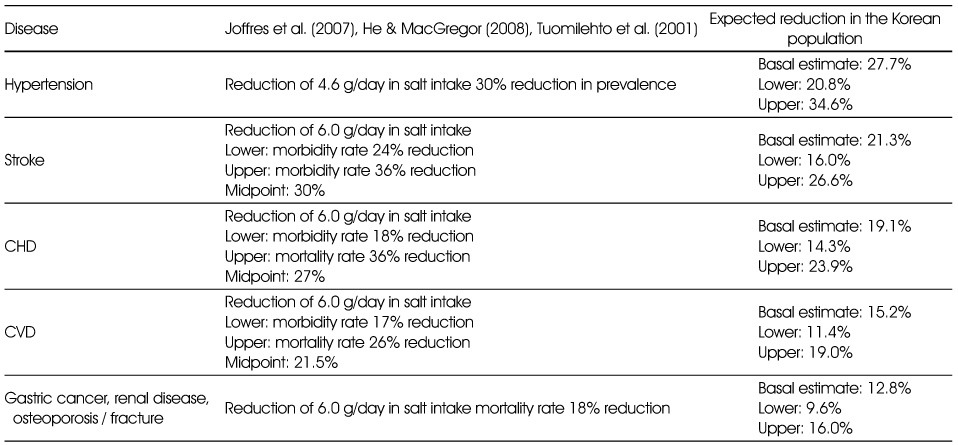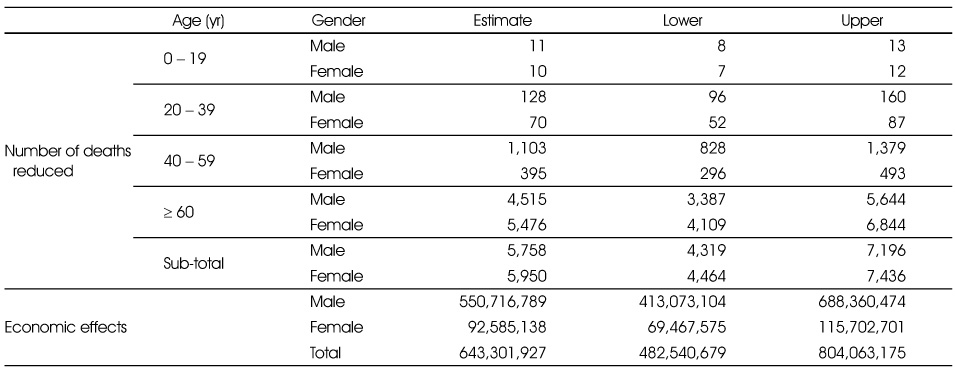Articles
- Page Path
- HOME > Korean J Community Nutr > Volume 17(3); 2012 > Article
-
Original Article
- Cost-benefit Analysis of Sodium Intake Reduction Policy in Korea
- Chulhee Lee, Dae-il Kim, Jeonglim Hong, Eunmi Koh, Baeg-won Kang, Jong Wook Kim, Hye-Kyung Park, Cho-il Kim
-
Korean Journal of Community Nutrition 2012;17(3):341-352.
DOI: https://doi.org/10.5720/kjcn.2012.17.3.341
Published online: June 30, 2012
Department of Economics, Seoul National University, Seoul, Korea.
1Department of Health Industry & Policy, Korea Health Industry Development Institute, Choongbuk, Korea.
2Nutrition Policy Office, Korea Food & Drug Administration, Choongbuk, Korea.
- Corresponding author: Cho-il Kim, Department of Health Industry & Policy, Korea Health Industry Development Institute, Osong-eup, Choongbuk 363-700, Korea. Tel: (043) 713-8611, Fax: (043) 713-8907, kimci@khidi.or.kr
Copyright © 2012 The Korean Society of Community Nutrition
- 2,283 Views
- 7 Download
- 16 Crossref
Abstract
- It is well established that excessive sodium intake is related to a higher incidence of chronic diseases such as hypertension, stroke, coronary heart disease, cardiovascular disease and gastric cancer. Although the upper limit of the current sodium intake guideline by WHO is set at 2,000 mg/day for adults, sodium intake of Koreans is well over 4,700 mg/capita/day implying an urgent need to develop and implement sodium intake reduction policy at the national level. This study investigated the cost-effectiveness of the sodium intake reduction policy, for the first time, in Korea. Analyses were performed using most recent and representative data on national health insurance statistics, healthcare utilization, employment information, disease morbidity/mortality, etc. The socioeconomic benefits of the policy, resulting from reduced morbidity of those relevant diseases, included lower medical expenditures, transportation costs, caregiver cost for inpatients and income losses. The socioeconomic benefits from diminished mortality included reductions in earning losses and welfare losses caused by early deaths. It is estimated that the amount of total benefits of reducing sodium intake from 4.7 g to 3.0 g is 12.6 trillion Korean Won; and the size of its cost is 149 billion Won. Assuming that the effect of sodium intake reduction would become gradually evident over a 5-year period, the implied rate of average return to the sodium reduction policy is 7,790% for the following 25 years, suggesting a very high cost-effectiveness. Accordingly, development and implementation of a mid-to-long term plan for a consistent sodium intake reduction policy is extremely beneficial and well warranted.
-
This research was supported by a grant (11162KFDA163) from Korea Food & Drug Administration in 2011.
NOTES
- 1. Ahn BC, Joung H. Socioeconomic cost of obesity in Korea. Korean J Nutr. 2005; 38(9): 786-792.
- 2. Blaustein MP, Hamlyn JM. Pathogenesis of essential hypertension : a link between dietary salt and high blood pressure. Hypertension. 1991; 18(5 Suppl): III184-III195.ArticlePubMed
- 3. Cappuccio FP, Kalaitzidis R, Duneclift S, Eastwood JB. Unravelling the links between calcium excretion, salt intake, hypertension, kidney stones and bone metabolism. J Nephrol. 2000; 13(3): 169-177.PubMed
- 4. Elliott P, Stamler J, Nichols R, Dyer AR, Stamler R, Kesteloot H, Marmot M. Intersalt Cooperative Research Group. Intersalt revisited: further analyses of 24 hour sodium excretion and blood pressure within and across populations. BMJ. 1996; 312(7041): 1249-1253.ArticlePubMedPMC
- 5. Gaziano TA, Steyn K, Cohen DJ, Weinstein MC, Opie LH. Cost-effectiveness analysis of hypertension guidelines in South Africa. Circulation. 2005; 112: 3569-3576.ArticlePubMed
- 6. Gibson J, Stillman S, Mckenzie D, Rohorua H. Natural experiment evidence on the effect of migration on blood pressure and hypertension. IZA Discussion Paper No. 5232. 2010.
- 7. He FJ, MacGregor GA. Effect of longer-term modest salt reduction on blood pressure. Cochrane Database Syst Rev. 2004; (3): CD004937.ArticlePubMed
- 8. He FJ, MacGregor GA. A comprehensive review on salt and health and current experience of worldwide salt reduction programmes. J Hum Hypertens. 2008; 23(6): 363-384.ArticlePubMedPDF
- 9. He J, Oqden LG, Vupputuri S, Bazzano LA, Loria C, Whelton PK. Dietary sodium intake and subsequent risk of cardiovascular disease in overweight adults. JAMA. 1999; 282(21): 2027-2034.ArticlePubMed
- 10. INTERSALT Cooperative Research Group. INTERSALT: an international study of electrolyte excretion and blood pressure. Results for 24 hour urinary sodium and potassium excretion. BMJ. 1988; 297(6644): 319-328.ArticlePubMedPMC
- 11. Joffres MR, Campbell NR, Manns B, Tu K. Estimate of the benefits of a population-based reduction in dietary sodium additives on hypertension and its related health care costs in Canada. Can J Cardiol. 2007; 23(6): 437-443.ArticlePubMedPMC
- 12. Jung YH, Ko SJ. Estimating socioeconomic cost of five major diseases. Korean J Public Finance. 2004; 18(2): 77-104.
- 13. Jung YH, Ko SJ. The socioeconomic cost of diseases in Korea. J Prev Med Public Health. 2006; 39(6): 499-504.PubMed
- 14. Korea Employment Information Service. 2009 Occupational employment statistics. 2010; cited 2011 May 20. Available from http://survey.keis.or.kr.
- 15. Korea Food & Drug Administration. Sodium reduction initiative - promoters' meeting. 2011; Press Release 26/12/2011.
- 16. Korea Food & Drug Administration. Korea Health Industry Development Institute. Cost-benefit analysis of sodium intake reduction policy and international collaboration with WHO for establishing sodium intake guidelines. 2012.
- 17. Korean Nutrition Society. Dietary reference intakes for Koreans. 2010; 1st revision. Seoul: Hanareum; 367-381.
- 18. Lee C. In-utero exposure to the Korean war and its long-term effects on health and economic outcomes. 2011; 2012 ASSA Meetings.
- 19. Meneton P, Jeunemaitre X, de Wardener HE, MacGregor GA. Links between dietary salt intake, renal salt handling, blood pressure, and cardiovascular diseases. Physiol Rev. 2005; 85(2): 679-715.ArticlePubMed
- 20. Ministry of Employment and Labor. Report on 2009 Wage Structure Survey. 2010; cited 2011 May 20. Available from http://www.moel.go.kr.
- 21. Ministry of Health and Welfare. Korea Centers for Disease Control & Prevention. Korea Health Statistics 2007: Korea National Health and Nutrition Examination Survey (KNHANES IV-1) 2007. 2008.
- 22. Ministry of Health and Welfare. Korea Centers for Disease Control & Prevention. Korea Health Statistics 2008: Korea National Health and Nutrition Examination Survey (KNHANES IV-2) 2008. 2009.
- 23. Ministry of Health and Welfare. Korea Centers for Disease Control & Prevention. Korea Health Statistics 2009: Korea National Health and Nutrition Examination Survey (KNHANES IV-3) 2009. 2010.
- 24. Ministry of Health and Welfare. Korea Centers for Disease Control & Prevention. Korea Health Statistics 2010: Korea National Health and Nutrition Examination Survey (KNHANES V-1) 2010. 2011.
- 25. Ministry of Health and Welfare. Korea Institute of Health and Social Affairs. The third Korea National Health & Nutrition Examination Survey (KNHANES III), 2005 - Health Interview Survey. 2006.
- 26. Murray CJL, Lauer JA, Hutubessy RCW, Niessen L, Tomijima N, Rodgers A, Lawes CMM, Evans DB. Effectiveness and costs of interventions to lower systolic blood pressure and cholesterol: a global and regional analysis on reduction of cardiovascular-disease risk. Lancet. 2003; 361(9359): 717-725.ArticlePubMed
- 27. National Health Insurance Corporation. Health Insurance Review & Assessment Service. 2008 National Health Insurance Statistical Yearbook. 2009; cited 2011 March 10. Available from http://www.nhic.or.kr.
- 28. National Health Insurance Corporation. Health Insurance Review & Assessment Service. 2009 National Health Insurance Statistical Yearbook. 2010; cited 2011 February 10. Available from http://www.nhic.or.kr.
- 29. National Health Insurance Corporation. Health Insurance Policy Research Institute. 2009 Survey on medical expenditure of patients insured by National Health Insurance. 2010; cited 2011 March 10. Available from http://www.nhic.or.kr.
- 30. Rhee M-Y, Yang SJ, Oh SW, Park Y, Kim C-i, Park H-K, Park SW, Park C-Y. Novel genetic variations associated with salt sensitivity in the Korean population. Hypertens Res. 2011; 34(5): 606-611.ArticlePubMedPDF
- 31. Rosen S. In: Ashenfelter O, Layard R, editors. The theory of equalizing differences. Handbook of Labor Economics. 1986; Volume 1: New York NY: North-Holland; 641-692s.
- 32. Selmer RM, Kristiansen IS, Haglerod A, Graff-Iversen S, Larsen HK, Meyer HE, Bønaa KH, Thelle DS. Cost and health consequences of reducing population intake of salt. J Epidemiol Community Health. 2000; 54(9): 697-702.PubMedPMC
- 33. Stamler J. The INTERSALT Study: background, methods, findings, and implications. Am J Clin Nutr. 1997; 65(2 Suppl): 626S-642S.ArticlePubMed
- 34. Stamler R. Implications of the INTERSALT study. Hypertension. 1991; 17(1 Suppl): I16-I20.ArticlePubMed
- 35. Statistics Korea. 2009 Economically Active Population Survey. 2010; cited 2011 May 15. Available from http://kosis.go.kr.
- 36. Statistics Korea. Annual Report on the Cause of Death Statistics (2010). 2011; cited 2011 February 16. Available from http://kostat.go.kr.
- 37. Strazzullo P, D'Elia L, Kandala N-B, Cappuccio F. Salt intake, stroke, and cardiovascular disease: meta-anlaysis of prospective studies. BMJ. 2009; 339: b4567.ArticlePubMedPMC
- 38. Tsugane S, Sasazuki S, Kobayashi M, Sasaki S. Salt and salted food intake and subsequent risk of gastric cancer among middle-aged Japanese men and women. Br J Cancer. 2004; 90(1): 128-134.ArticlePubMedPMCPDF
- 39. Tuomilehto J, Jousilahti P, Rastenyte D, Moltchanov V, Tanskanen A, Pietinen P, Nissinen A. Urinary sodium excretion and cardiovascular mortality in Finland: a prospective study. Lancet. 2001; 357(9259): 848-851.ArticlePubMed
- 40. World Health Organization. Diet, nutrition and the prevention of chronic diseases. ort of a joint WHO/FAO Expert Consultation. 2003; Geneva: World Health Organization; (WHO Technical report series, No. 916).
- 41. World Health Organization. Creating an enabling environment for population-based salt reduction strategies. Report of a joint technical meeting held by WHO and the Food Standards Agency. 2010a; July 2010. United Kingdom.
- 42. World Health Organization. International statistical classification of diseases and related health problems, 10th Revision. ICD-10 Version:2010. 2010b; cited 2011 March 10. Available from http://apps.who.int/classifications/icd10/browse/2010/en.
- 43. World Health Organization. Call for public comments on the scoping of sodium and potassium recommendations. 2011; cited 2011 February 10. Available from http://www.who.int/nutrition/events/NUGAG_dietandhealth_subgroup_call_public_comment_scope_of_Na_K.pdf.
- 44. World Health Organization. Call for public comments - Draft WHO Guidelines sodium and potassium. 2012; cited 2012 February 3. Available from http://www.who.int/nutrition.
REFERENCES

1) International Classification of Diseases (WHO 2010b)
Figure & Data
REFERENCES
Citations

- Self-Reported Diet Management and Adherence to Dietary Guidelines in Korean Adults with Hypertension
Jee-Seon Shim, Kyungwon Oh, Sun Jae Jung, Hyeon Chang Kim
Korean Circulation Journal.2020; 50(5): 432. CrossRef - Progress on sodium reduction in South Korea
Hye-Kyung Park, Yoonna Lee, Baeg-Won Kang, Kwang-il Kwon, Jong-Wook Kim, Oh-Sang Kwon, Laura K Cobb, Norman R C Campbell, Drew E Blakeman, Cho-il Kim
BMJ Global Health.2020; 5(5): e002028. CrossRef - Customers' Perceptions of Operational Status of and Needs for Sodium Reduction in the Industry Foodservice in Seoul
Na-Young Yi
Korean Journal of Community Nutrition.2020; 25(1): 21. CrossRef - Systematic Review on International Salt Reduction Policy in Restaurants
Jingmin Ding, Yuewen Sun, Yuan Li, Jing He, Harriet Sinclair, Wenwen Du, Huijun Wang, Puhong Zhang
International Journal of Environmental Research and Public Health.2020; 17(24): 9570. CrossRef - Association between dietary sodium intake and disease burden and mortality in Koreans between 1998 and 2016: The Korea National Health and Nutrition Examination Survey
Clara Yongjoo Park, Garam Jo, Juhee Lee, Gitanjali M. Singh, Jong-Tae Lee, Min-Jeong Shin
Nutrition Research and Practice.2020; 14(5): 501. CrossRef - Development of standards for reducing the sodium content and salinity of Korean fermented soybean sauces and representative Korean foods high in sodium
Lin Jiang, Eun-Kyung Shin, Jung-Sook Seo, Yeon-Kyung Lee
Journal of Nutrition and Health.2019; 52(2): 185. CrossRef - Socioeconomic burden of sugar-sweetened beverages consumption in Korea
Jee-Seon Shim, Nam Hoon Kang, Jung Sug Lee, Ki Nam Kim, Hae Kyung Chung, Hae Rang Chung, Hung-Ju Kim, Yoon-Sook Ahn, Moon-Jeong Chang
Nutrition Research and Practice.2019; 13(2): 134. CrossRef - The association between dietary sodium intake and adiposity, inflammation, and hormone markers: A preliminary study
Jeong-Hwa Choi, Young-Ran Heo
Journal of Nutrition and Health.2017; 50(6): 578. CrossRef - Low Salt Diet and Insulin Resistance
Hyunwoo Oh, Hyo Young Lee, Dae Won Jun, Seung Min Lee
Clinical Nutrition Research.2016; 5(1): 1. CrossRef - Quality of White Bread Containing Aster yomena Powder
Yong-Joo Kim, Ji-Suk Jeong, Eun-Ha Kim, Byeong-Gil Son, Geun-Bae Go
Journal of the Korean Society of Food Science and Nutrition.2016; 45(1): 91. CrossRef - Nutrition knowledge, eating attitudes, nutrition behavior, self-efficacy of childcare center foodservice employees by stages of behavioral change in reducing sodium intake
Yun Ahn, Kyung Won Kim, Kyungmin Kim, Jinwon Pyun, Ikhyun Yeo, Kisun Nam
Journal of Nutrition and Health.2015; 48(5): 429. CrossRef - Optimization of Hot Water Extraction Conditions of Wando Sea Tangle (Laminaria japonica) for Development of Natural Salt Enhancer
Hyo Ju Kim, Eun Ju Yang
Journal of the Korean Society of Food Science and Nutrition.2015; 44(5): 767. CrossRef - The Study on Dietary Behavior and Health Related Behaviors of Self Perceived Sodium Intake Groups
Juhyeon Kim, Hei-Ryeo Yoon, Nam-E Kang
Journal of The Korean Society of Food Culture.2014; 29(6): 511. CrossRef - Comparison of sodium content of workplace and homemade meals through chemical analysis and salinity measurements
Eun-Kyung Shin, Yeon-Kyung Lee
Nutrition Research and Practice.2014; 8(5): 558. CrossRef - Effects of Dietary Education on Low-sodium Diet Adaptation
Hae Young Kim, Juhyeon Kim
Journal of the Korean Society of Food Culture.2014; 29(2): 212. CrossRef - Excessive Sodium Intake and Related Factors According to Energy Intakes Among Korean Elderly: A Nationwide Cross-Sectional Study
Young-Jin Tak, Jeong-Gyu Lee, Yun-Jin Kim, Sangyeoup Lee, Dong-Wook Jung, Yu-Hyeon Yi, Young-Hye Cho, Eun-Jung Choi, Seung-Hun Lee, Hye-Lim Hwang, A-Ra Cho
Journal of the Korean Geriatrics Society.2014; 18(4): 185. CrossRef
Diseases considered in cost-benefit analysis of sodium intake reduction policy
1) International Classification of Diseases (WHO 2010b)
Expected effect of salt intake reduction on specific diseases
Estimated reduction in health-care costs
unit: 103 won (in 2009)
Estimated reduction in cost of death based on human capital approach
unit: 103 won (in 2009)
Estimated reduction in cost of death based on the estimated value of life
unit: 103 won (in 2009)
Overall benefits of sodium intake reduction
unit: 103 won (in 2009)
Estimated cost of sodium intake reduction policy
unit: million USD, 103 won (in 2009)
Rate of return (%) to investment in sodium intake reduction
1) International Classification of Diseases (
unit: 103 won (in 2009)
unit: 103 won (in 2009)
unit: 103 won (in 2009)
unit: 103 won (in 2009)
unit: million USD, 103 won (in 2009)

 KSCN
KSCN







 Cite
Cite


